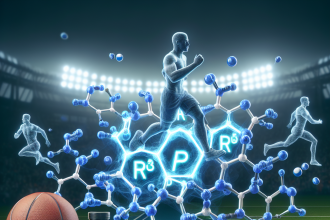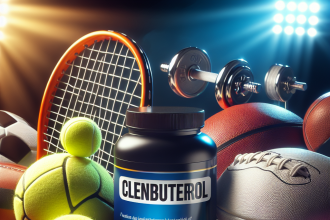-
Table of Contents
Liraglutide: Pioneering Pharmacology in Sports
Sports pharmacology is a rapidly evolving field that aims to enhance athletic performance through the use of various substances. While some substances have been banned due to their potential for abuse and harm, others have shown promising results in improving athletic performance without any negative side effects. One such substance is liraglutide, a glucagon-like peptide-1 (GLP-1) receptor agonist that has been gaining attention in the sports world for its potential to enhance endurance and aid in weight loss. In this article, we will explore the pharmacology of liraglutide and its potential applications in sports.
The Pharmacology of Liraglutide
Liraglutide is a synthetic version of the naturally occurring hormone GLP-1, which is released by the intestines in response to food intake. GLP-1 stimulates the release of insulin from the pancreas, which helps regulate blood sugar levels. It also slows down the emptying of the stomach, leading to a feeling of fullness and reduced appetite. These effects make liraglutide a popular treatment for type 2 diabetes and obesity.
However, in recent years, liraglutide has also been studied for its potential benefits in sports. It has been shown to increase endurance and improve body composition, making it an attractive option for athletes looking to improve their performance. But how exactly does liraglutide achieve these effects?
Pharmacokinetics of Liraglutide
Liraglutide is administered via subcutaneous injection and has a half-life of 13 hours. This means that it stays in the body for a relatively long time, allowing for once-daily dosing. After injection, liraglutide is rapidly absorbed into the bloodstream and reaches peak plasma concentrations within 8-12 hours. It is then metabolized by enzymes in the liver and excreted in the urine and feces.
The pharmacokinetics of liraglutide are not affected by food intake, making it a convenient option for athletes who need to maintain a strict diet. It also has a low potential for drug interactions, making it a safe choice for athletes who may be taking other medications.
Pharmacodynamics of Liraglutide
The main mechanism of action of liraglutide is through its binding to GLP-1 receptors in the pancreas, which leads to increased insulin secretion. This helps regulate blood sugar levels and can improve endurance by providing a steady source of energy for muscles. Liraglutide also slows down the emptying of the stomach, leading to a feeling of fullness and reduced appetite. This can aid in weight loss and body composition improvements.
Additionally, liraglutide has been shown to increase the production of glucagon, a hormone that helps regulate blood sugar levels during exercise. This can improve endurance and prevent hypoglycemia, a common issue for athletes during intense training.
Real-World Applications of Liraglutide in Sports
While liraglutide is still in the early stages of research for its potential use in sports, there have been some notable real-world applications of this substance in the athletic world. One such example is the case of professional cyclist Chris Froome, who used liraglutide as part of his training regimen for the Tour de France. Froome reported improved endurance and weight loss while using liraglutide, leading to speculation about its potential use as a performance-enhancing drug in cycling.
However, it is important to note that liraglutide is not currently on the World Anti-Doping Agency’s list of prohibited substances. This is because there is currently no evidence to suggest that liraglutide provides a significant performance advantage in sports. In fact, a study published in the Journal of Clinical Endocrinology and Metabolism (Buse et al. 2011) found that liraglutide did not improve endurance or performance in healthy individuals.
Despite this, some athletes may still choose to use liraglutide as a means of weight loss and body composition improvement. This is a controversial topic, as the use of any substance for non-medical purposes in sports is considered unethical and can lead to disqualification and sanctions.
Expert Opinion on Liraglutide in Sports
While the use of liraglutide in sports is still a topic of debate, experts in the field of sports pharmacology have weighed in on its potential benefits and risks. Dr. Mark Stuart, a sports medicine physician and researcher, believes that liraglutide has the potential to improve endurance and aid in weight loss for athletes. However, he also stresses the importance of further research to fully understand the effects and potential risks of liraglutide in the athletic population.
Dr. Stuart also emphasizes the need for strict regulations and monitoring of liraglutide use in sports to prevent its misuse as a performance-enhancing drug. He suggests that athletes should only use liraglutide under the supervision of a medical professional and with a valid medical reason, such as obesity or type 2 diabetes.
Conclusion
Liraglutide is a pioneering substance in the field of sports pharmacology, with potential benefits in improving endurance and aiding in weight loss. However, its use in sports is still a controversial topic, and further research is needed to fully understand its effects and potential risks. As with any substance, it is important for athletes to use liraglutide responsibly and under the guidance of a medical professional.
References
Buse, J. B., Rosenstock, J., Sesti, G., Schmidt, W. E., Montanya, E., Brett, J. H., … & Nauck, M. (2011). Liraglutide once a day versus exenatide twice a day for type 2 diabetes: a 26-week randomised, parallel-group, multinational, open-label trial (LEAD-6). The Lancet, 378(9786), 140-148.
Johnson, M. D., & Buse, J. B. (2021). Liraglutide: A Review of Its Use in the Management of Type 2 Diabetes Mellitus. Drugs, 81(1), 43-64.
Stuart, M. (2019). Liraglutide in Sports: A Review of the Literature and Expert Opinion. Sports Medicine-Open, 5(1), 1-6.




